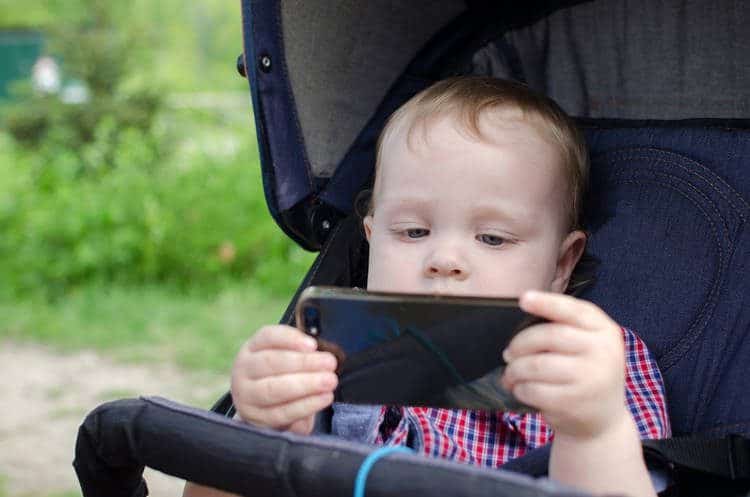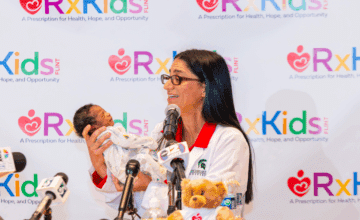Nina F. Newman, Fielding Graduate University

Abstract
Media use by young children, even those 2 years old and younger, continues to increase. Many parents and professionals believe media, including digital devices, enhances cognitive and overall development. However, there is a misconception about what promotes healthy minds and bodies. Brain development, the foundation for all abilities, including cognitive, physical, social–emotional, speech and language, and regulation of all these elements, relies on early relationships. With the increase in media use by children and parents, these critical relationships may be compromised, with potentially long-term negative consequences. Only by putting relationships first and foremost will children develop healthy minds, successful social skills, and regulated bodies.
During a recent parenting group, including an infant, toddler, and first-grader, a parent of three cheerfully shared that Alexa, a cloud-based voice technology, had transformed the family’s life. The parents placed Alexa in the center of the kitchen table and instructed the older children to ask it any questions they wished. The parents had also given Alexa the task of reading nightly bedtime stories. Another parent then shared how easy it was to entertain and educate her 9-month-old by propping up a tablet in the crib. While these examples may seem extreme, the reality is that toddlers and older infants can regularly be seen sitting in strollers, engrossed in a game on a phone or swiping back and forth to watch light and colors shift.
While many parents believe early introductions to technology will give their children an academic edge over peers or, at least not leave them behind, there are misconceptions about what underlies healthy brain development and, therefore, school readiness, academic achievement, and successful relationships. Many parents no doubt are well-intentioned and, perhaps, believe Alexa may know more than they do or has more patience at the end of the day to read stories. However, Alexa is not the 21st century answer to Mary Poppins. Endless facts and a disembodied voice, no matter how knowledgeable, will not lead to the kinds of minds parents imagine or society needs. A curious, sound mind begins with a healthy brain. The brain is the structure upon which all else is built. While each brain comes with individual strengths and weaknesses, how its potential is realized relies on relationships and experiences in the world. Hence, positive relationships and experiences create healthier brains and, therefore, more capable minds.
Human beings also come into existence with a brain primed for certain human-specific experiences, critical for development. If these do not occur, whatever innate potential they have may not be realized. For example, the brain is specifically wired for faces because a foundational experience in early development is that of a loving, face-to-face, consistent, regulating relationship with a primary caregiver. No machine, no matter how sophisticated, can replace this. If this relationship is disrupted or supplanted by, let’s say, an electronic device, typical development can be derailed and a child may go on to struggle to read faces, a crucial communication and relationship skill. Or, a child may have difficulties with emotional regulation, which then compromises attention, concentration, and school readiness. In other words, these early experiences are critical for all that comes next, including self-regulation, empathy, executive functions, academic achievement, and social skills. Consequently, introduction of technology at younger and younger ages, especially if it supplants social–emotional interactions with caregivers, may result in lifelong challenges for children and families. In fact, there are concerns that early and frequent exposure to technological devices may overdevelop areas of the brain prematurely, taxing or distorting future brain networks, while crucial areas that need development may be neglected. Increased exposure to media in young children has also been shown to negatively impact sleep (Beyens & Nathanson, 2018); reduce physical activity, setting the stage for obesity later in life (Hinkley, Salmon, Okely, Crawford, & Hesketh, 2012); and contribute to cognitive challenges (Lin, Cherng, Chen, Chen, & Yang, 2015), language difficulties (Zimmerman, Christakis, & Meltzoff, 2007), and social–emotional issues (American Academy of Pediatrics Council on Communications and Media, 2016; Hinkley et al., 2014).
However, children’s use of technology is only half the story. Recently, a director of a large early childhood program bemoaned the fact that parents came into school with their eyes on their phones, handing off their children without looking up from their screens. Some children tried to make connections with parents before being separated, but often to no avail. Others didn’t even try, they themselves distracted. Eventually, the director banned the use of phones at school. Yet, she still despaired because these issues continued outside of school.
In part, these challenges are the result of living in the 21st century. Work can be every day and any time. Adults are bombarded by information on devices 24/7, making it difficult to decipher what is important and what is not. Consequently, parents are finding it harder to regulate themselves, let alone their children. Perhaps it’s not surprising young children are given devices to keep them quiet, manage their behavior, and babysit them. This lack of co- and self-regulation may also be a contributor to the escalation of mental health issues in young children and families. At younger and younger ages, children are being expelled from school for disruptive behaviors and mood problems. In fact, early childhood populations are being expelled at 3 times the rate of elementary and high school counterparts (Gilliam, 2005). Futhermore, mental illness, such as attention deficit hyperactivity disorder, depression, and anxiety, is on the rise in young children across all socio-economic levels (Centers for Disease Control and Prevention, 2013).
Somehow, in the swell of virtual limitlessness and technology, humans have lost an understanding that they are hard wired to be connected to each other. Through face-to-face interactions. Through human touch. Through commitment, relationships, and love. They have let slip that what they say and do has real world consequences. Infants, young children, and families are not in trouble because they don’t have the latest electronic device. They are in trouble because they are struggling to maintain person-to-person connection with others, especially with the youngest and most vulnerable. Despite technological advances, humans still need social–emotional experiences to ensure healthy development and to reach their potential. Relationships are how children learn to regulate their emotions and their bodies. It is how they build resilience and become successful in school and life. These relationships safeguard against loneliness, depression, and other mental health problems. If humans are connected to others in a healthy manner, they are less likely to perpetrate aggressive acts against others because they will intuitively understand there are consequences to their actions and that others feel as they do.
It is that simple. And that complicated. It can be hard work. It can be messy. But there is no way around it. Adults cannot fix or make better the type of problems occuring in families, child care, pre-school, and everyday life without putting down and shutting off, at least for a good part of the time, electronic devices. Adults need to be with their infants and children. They need to look children in the eye, think, and feel before they speak. They have to model healthy behavior. Adults have to rebuild their attention spans–research shows an average attention span of 8 seconds (Microsoft Canada, 2015) doesn’t really cut it–and regulate themselves, so they can help regulate infants and children.
While technology misuse is not the sole cause of society’s problems and no doubt there are benefits to it, such as connecting with family and expanding educational opportunities, technology is, nonetheless, a resource like any other. It must be used appropriately in the right circumstances and at the right time. Human beings need to be its master, not its servant. The difficulties children and families face will not be solved by driverless cars, people-seeking drones, social media, or apps. Even if Silicon Valley designs the next best thing to sell parents and educators, it will miss the point and adults must say so.
Social–emotional development, via in-your-face, hands-on relationships, underlies all human development. Without this foundation, built in the critical years from birth to 5 years old, children will not be prepared for the journey ahead. Not in school, at work, or in relationships. Many parents and professionals may pause upon reading this. Life is hectic and stressful for many. However, be assured that most adults already have what they need to be good parents. Take your infant or toddler to the market. Talk to them. Show them a tomato. Tell them about the red color and the round shape. When they smile at you, look at them and smile back. Answer their coos. Make up your own stories. Share them when you pick them up from day care, whether you drive a car or ride the bus home. There are spaces in everyday life to make time together. Be curious about why children aren’t comfortable, why they are teary, or why it is hard to share. Problem solve. Look to yourselves–did you have a hard day? Maybe your child can feel you are not comfortable. Listen. Small moments have a huge impact. Even better: they don’t have to cost a cent.
When these infants and children are adults, they won’t remember what game they played on your phone, but they will remember you, your attention, and care. They will remember all the small moments, not in words, but in how they are in everyday life, how well they do in school or at work, and how well they do with others. The time you spend with them in these early stages will be in the fiber of their being. Even with your busy schedule, let them know that you see them, and that you care about what they say and how they feel. Fumble with them through the difficult, imperfect moments. In the end, you are in it together. It will make all the difference.
Author
Nina F. Newman, PhD, is program lead and co-developer of the master’s program in Infant and Early Childhood Development (IECD) with an Emphasis in Mental Health and faculty in the IECD doctoral program at Fielding Graduate University. Dr. Newman is a clinical psychologist with a background in neuropsychology as well. She has developed and implemented education programs as well as training for parents, early childhood educators, health, allied health, and mental health professionals. In addition, she has an expertise in social-emotional development, executive functions, and psychiatric disorders as a result of pediatric traumatic brain injuries. She has experience with individual and group therapeutic settings and assessment clinics.
Suggested Citation
Newman, N. F. (2018). PERSPECTIVES—Early childhood, media use, and development: Human touch first and foremost. ZERO TO THREE Journal, 39(2), 36–38.
References
American Academy of Pediatrics Council on Communications and Media. (2016). Media and young minds. Pediatrics, 138(5), e20162591.
Beyens, I., & Nathanson, A. I. (2018). Electronic media use and sleep among preschoolers: Evidence for time-shifted and less consolidated sleep. Health Communication, 1–8. DOI: 10.1080/10410236.2017.1422102
Centers for Disease Control and Prevention. (2013). Mental health surveillance among children—United States 2005–2011. Morbidity and Mortality Weekly Report, 62(2). Source
Gilliam, W. S. (2005). Prekindergarteners left behind: Expulsion rates in state prekindergarten systems. Yale Child Studies Center; New Haven, CT.
Hinkley, T., Salmon, J., Okely, A. D., Crawford, D., & Hesketh, K. (2012). Preschoolers’ physical activity, screen time, and compliance with recommendations. Medicine & Science in Sports & Exercise, 44(3), 458–465.
Hinkley, T., Verbestel, V., Ahrens, W., Lissner, L., Molnair, D., Moreno, L.A., De Bourdeaudhuij, I. (2014). Early childhood electronic media use as a predictor of poorer well-being. Pediatrics, 168(5), 485–492.
Lin, L-Y, Cherng, R-J., Chen, Y-j., Chen, Y-J., & Yang, H-M. (2015). Effects of television exposure on development skills among young children. Infant Behavior and Development, 38, 20–26.
Microsoft Canada. (2015). Attention spans. Consumer Insights, Spring, 1–51. Source
Zimmerman, F. J., Christakis, D. A., & Meltzoff, A. N. (2007). Associations between media viewing and language development in children under age 2 years. Journal of Pediatrics, 151(4), 364–368.




